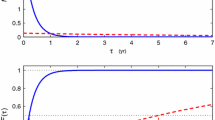Summary
The interdependence of earthquakes is strongly suggested by the distribution of foci in the earth. With the exception of earthquake sequences, as aftershocks, foreshocks and earthquake swarms the interdependence of earthquakes is much less obvious from their relative occurrence times.
Several statistical tests are devised for the purpose of investigating the interrelations of earthquakes on the basis of the relative occurrence times. The tests are applied to a regional and a world-wide earthquake population. The tests reveal occurrence patterns for earthquakes which might otherwise appear to take place independently of each other. The patterns are found to disappear, if earthquakes occurring within 1° arcuate distance of each other are excluded from the regional population, and such within 5° arcuate distance of each other from the world-wide population.
The relative ease with which the interdependence of earthquakes is recognized in the domain of space, and the relative difficulty with which it is found in the domain of time is considered as evidence for earthquakes being only symptomatic of other tectonic movements, not accessible to the conventional method of observation.
Similar content being viewed by others
References
Båth, M., andDuda S. J. (1964),Earthquake volume, fault plane area, seismic energy, strain, deformation and related quantities, Annali Geofis.17, 353–368.
California Department of Water Resources,Strain and Fault Movement Investigation (1964).
Duda, S. J. (1965),Secular seismic energy release in the circum-Pacific belt, Tectonophysics2, 409–452.
Gutenberg, B., andRichter, C. F.,Seismicity of the Earth and Associated Phenomena (Princeton University Press 1954).
Richter, C. F. Elementary Seismology (W. H. Freeman and Co., San Francisco 1958).
Utsu T. (1961),A statistical study on the occurrence of aftershocks, Geophys. Mag.30, 521–605.
Walsh, J. E.,Handbook of Nonparametric Statistics (D. Van Nostrand Co., Inc., Princeton 1962).
Weast, R. C., Selby, S. M., andHodgman, C. D.,Mathematical Tables, Handbook of Chemistry and Physics, (The Chemical Rubber Co., Cleveland, Ohio 1964).
Wideman, C. J., andMajor, M. W. (1967),Strain steps associated with earthquakes, Bull. Seism. Soc. Am.57, 1429–1444.
Author information
Authors and Affiliations
Rights and permissions
About this article
Cite this article
Powell, J.A., Duda, S.J. A statistical study of earthquake occurrence. PAGEOPH 113, 447–460 (1975). https://doi.org/10.1007/BF01592930
Received:
Issue Date:
DOI: https://doi.org/10.1007/BF01592930




